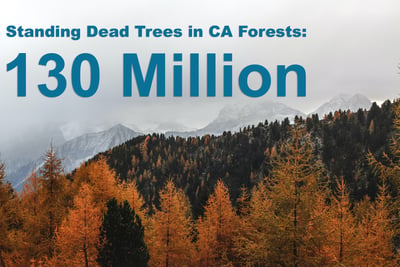Because of the cumulative effects of climate change, the severity of seasonal wildfires in the Western US has increased and, unfortunately, accelerated the destruction of life, communities, and property. Millions of residents in portions of California and the Pacific Northwest (PNW) have literally been choking on wildfire smoke for the last several weeks.
While naturogenic fire has been an important part of restorative forest management for eons, the megafires that have devastated th e region in recent decades are largely anthropogenic. Past policy initiatives and years of fire suppression have prohibited the active management of western forests, which has resulted in an accumulation of fuel on the forest floor. Compounding the issue is the more than 130 million standing dead trees in California forests. With such a fuel load, fires are now hotter, larger, and more destructive than they would otherwise be.
e region in recent decades are largely anthropogenic. Past policy initiatives and years of fire suppression have prohibited the active management of western forests, which has resulted in an accumulation of fuel on the forest floor. Compounding the issue is the more than 130 million standing dead trees in California forests. With such a fuel load, fires are now hotter, larger, and more destructive than they would otherwise be.
As a result, millions of acres of timberland now burn needlessly every year in western states, which also releases millions of tons of contaminants into the atmosphere. This predicament—as well as the rolling blackouts—has prompted us to ask two intriguing questions:
- How much energy is released from these megafires?
- What would be the equivalent generating capacity if the burned forest biomass had been converted to electricity?
We estimated the amount of biomass burned in California over the last 30-day period (3.4 million acres) and converted it to electrical power that could have been beneficially generated from the biomass. The result was shocking: 58,000 Megawatt Hours (MWh)!
If that generating capacity was spread over a full year rather than 30 days, the biomass would have supported the generation of 5,000 gigawatt hours (GWH). In comparison, the current annual generating capacity in California is 80 GWh.
This means that, on average, the recent megafires in California are generating enough energy to power the state of California for the next 62 years! This generating rate is also 4.5 times the total annual generating capacity of the entire US!
Now, we are not proposing that all of that biomass could—or even should—be used for power generation. Rather, we are saying that a small portion of that resource should be removed from the forest to reduce the intensity of wildfires while being used to beneficially generate renewable electricity and other bio-based products, including biofuels and biochemicals.
What is it going to take?
Fortunately, the US Forest service is now receptive to removing low-value biomass from national forests, which make up 50% of the total forest coverage in California. What does the state now need to tackle this problem head on? Economically viable markets for this low-value material, and biomass power is an obvious solution.
At one point, there were dozens of biomass power plants in California. Most of those plants are no longer operating because they could not secure viable power purchase agreements. Through Renewable Portfolio Standards, states can mandate generating portfolio mix, including specifying a minimum amount of biomass-based power. Biomass power is more expensive than fossil-based power, but the cost of generating isn’t the complete picture.
Read Our Additional Commentary: Common Misconceptions About Bioenergy
California currently spends $2.5 BILLION each year for fire prevention and suppression. If just a small portion of that budget were redirected to support economically feasible, long-term power purchase agreements, we could see a resurgence in renewable biomass power generation in the state. One GW of biomass-based power generation would convert approximately 10 million tons of low-value biomass each year to renewable power—low-value biomass that otherwise may end up as fuel for wildfires.
While this is a simple analysis, the facts are quite clear: Every year, millions of acres of western forests burn due to wildfires resulting in a tremendous loss of life, property, forest resources, as well as a loss of potential energy.
Although the solutions for mitigating climate change are not simple, we are hopeful that state and federal governments will come to see biomass power as a renewable, available and valuable tool. It makes environmental sense to utilize low-value biomass to create clean power rather than allowing it to fuel raging, destructive wildfires year after year. Now, it must make economic sense, and that is in the hands of legislators.









